It is too early to say that the Japanese animation IP’s realizing ability has declined because Japanese animation companies’ revenue from the commercialization market has grown significantly within 3 years.
Editor’s note: This article is from WeChat public account “ 三 文 娱乐 ” (ID: hi3wyu ), The author Dazhu.
Commercialization, as a sector in the animation industry, has been an important means of monetization and one of the ways to reflect the IP value of a work. However, according to the public data of the “Japan Animation Industry Report” in recent years, the size of the Japanese animation commercialization market has fallen for 4 consecutive years to 2018, and it has shown a trend of continued shrinking.
Does this mean that the monetization ability of Japanese animation IP is gradually declining and it is no longer good to make money?
Before answering this question, we should note that the data provided by the Report are mainly targeted at the retail sector, or the “physical” consumer market; and non-physical products such as mobile games and emoticons The market is not reflected in it.
In other words, The decline of the Japanese commercialization market reflects the difficulties faced by the physical commercialization market and the transformation of the Japanese animation industry’s commercialization market in the new economic environment, especially in the booming digital economy Demand .
As a result, it is too early to say that the Japanese animation IP ’s ability to monetize will decline, at least Japanese animation companies ’revenue from the commercialized market Significant growth in 3 years .
In 2018, the Japanese commercialization market, which entered the transition period, showed some new trends.
At the same time, the commercial value of IP core elements such as animated characters , worldview also tends to be diversified, giving more flexibility in areas such as advertising and promotion And creative.
p>
The purchasing power of core fans has weakened, and roles have become increasingly “short-lived”
The size of the Japanese retail product market in 2018 was 1 trillion 533 billion yen (equivalent to about 981 yuan)Billion yuan) , a year-on-year decrease of 1.7%.
This is the fourth consecutive year of decline.

(According to the public information of “Japan Animation Industry Report 2019”)
As the overall retail market for character goods continues to shrink, the anime character goods market in Japan in 2018 also fell 4.4% year-on-year to 500.3 billion yen .
This is a new low for 11 years since 2008.
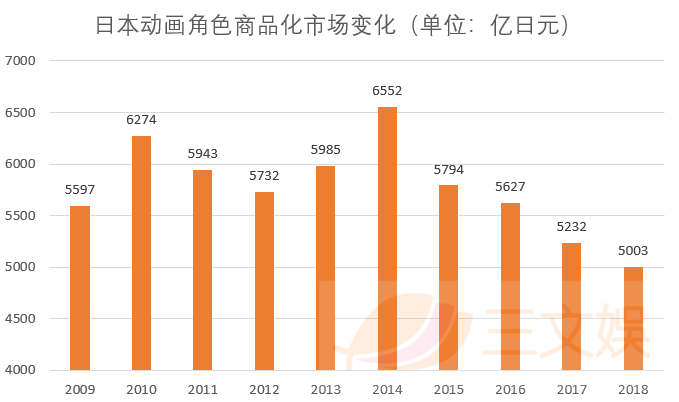
(According to the public information of “Japan Animation Industry Report 2019”)
Although the broad market has been stagnant for years, the animation company’s revenue from the commercialization of characters has increased for three consecutive years.
In 2018, Commercialization revenue of animation companies was 42.5 billion yen , a year-on-year increase of 23.2%.
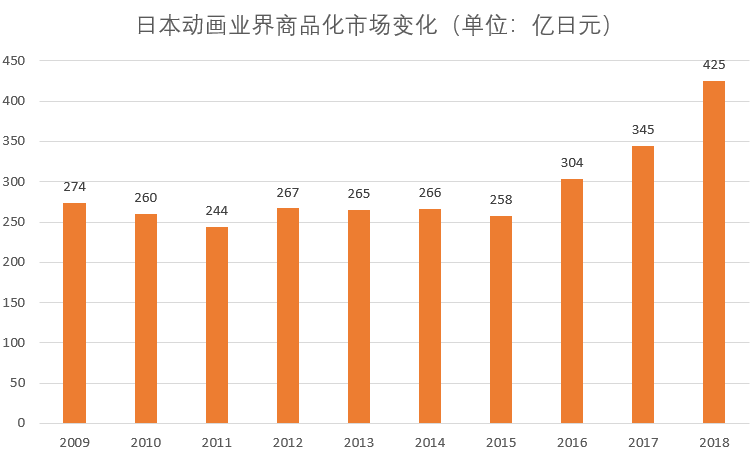
(According to the public information of “Japan Animation Industry Report 2019”)
This does not include LINE emoticons and mobile game materials.
It is estimated that the scale of the animation-related mobile game market represented by “Dragon Ball Z Burst War” has exceeded 400 billion yen . And core powderSilk-oriented classics are increasingly tilted from “material” to “digital” and have become an important source of revenue for production committees.
In terms of audience type, the children’s and household goods market accounted for 87.4% of the total in 2018 , which has expanded from 84.8% of last year. “Beauty Girl of Light”, “Kamen Rider”, “Shinkansen Transform Robot SHINKALION” and “Pokemon” classics have all maintained good sales. However, in the children’s market, TV viewing time has greatly reduced, and YouTube viewing time has increased significantly, and the environment is still very severe.
In other countries, the media for children’s groups is also shifting from TV to online media such as YouTube. Every year, when the gift purchase season is reached, the store’s facade is decorated with the same role. Right now, it is indeed an economic model that has to face the traditional TV-centric merchandise sales strategy since the Japanese tradition.
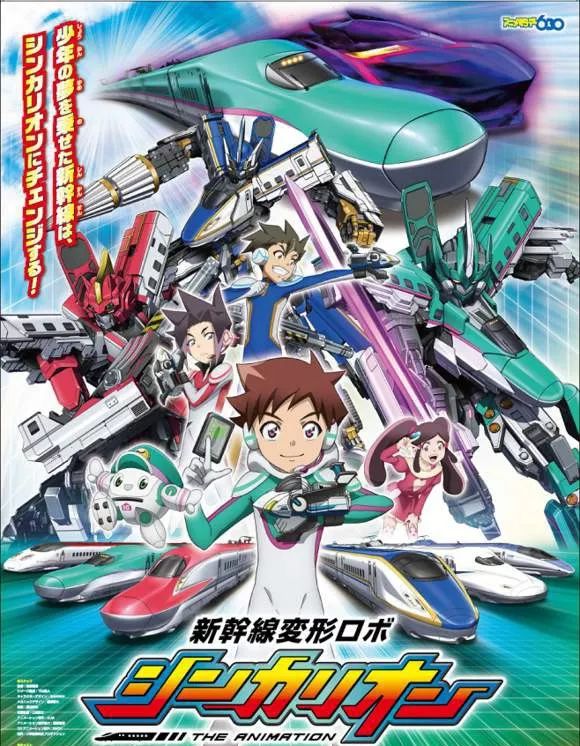
On the other hand, money for adults is not so easy to make.
in the previous three entertainment report interpretation ( “ The rise of late night animation, Japanese TV stations are changing their business models “), and it has been mentioned that since 2015, the late night animation production time has begun to exceed the full-day animation. Full-day animation is mainly for children and families, while late-night animation is mainly for core fans and youth groups. The profit point of late-night animation does not lie in the right to play television. It relies more on the secondary income of copyrights such as optical discs, overseas and commercialization.
However, it is uncomfortable that the increase in the number of late night animations invested in a large amount of cost has not brought the core fans to the commercialized market. Although the proportion of core fans to the commoditization market has increased significantly in 2015 and 2016, it has rapidly declined since 2017, and the proportion in 2018 has even fallen back to the levels in 2011 and 2012.
Insufficient staying power from the core to the commoditized market, coupled with the social status of declining child population, has weakened children’s purchasing power from consumer groups. The downturn in the “physical” commoditized market is conceivable. Therefore, in recent years, the capital side has begun to devote more energy and resources to the development of “digital” commoditization. With the help of mobile games, social media and other currently active media spaces, young people are trying to regain the hearts of customers.
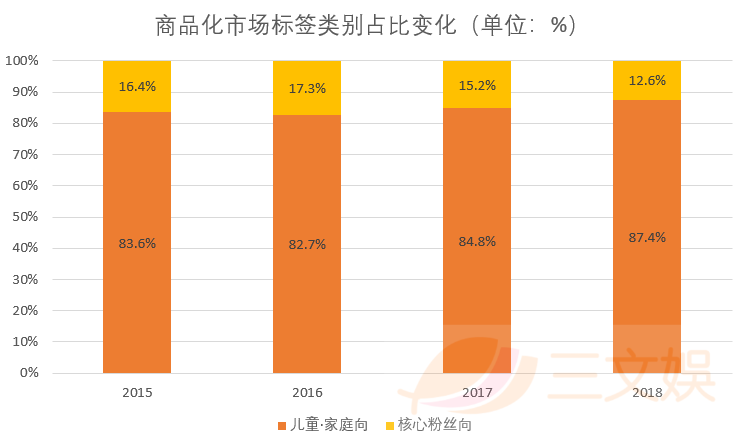 The reason for the shrinking market in 2018 is the lack of new popular characters At the same time, sales of previous classic characters have decreased. But the more important reason behind it is that the awareness of domestic consumers in Japan has changed in recent years.
The reason for the shrinking market in 2018 is the lack of new popular characters At the same time, sales of previous classic characters have decreased. But the more important reason behind it is that the awareness of domestic consumers in Japan has changed in recent years.
Until the mid-2010s, the consumer stratification boundary between decorative characters (such as Disney Mickey Mouse and Donald Duck) and Japanese animated characters was relatively clear, and there was almost no overlap between consumers in various categories. But now there are more and more young female consumer groups, who like decorative characters and animated characters, and it is not uncommon to walk between ANIMATE and KIDDY LAND. That said, consumer spending on “shallow and broad” roles has increased.
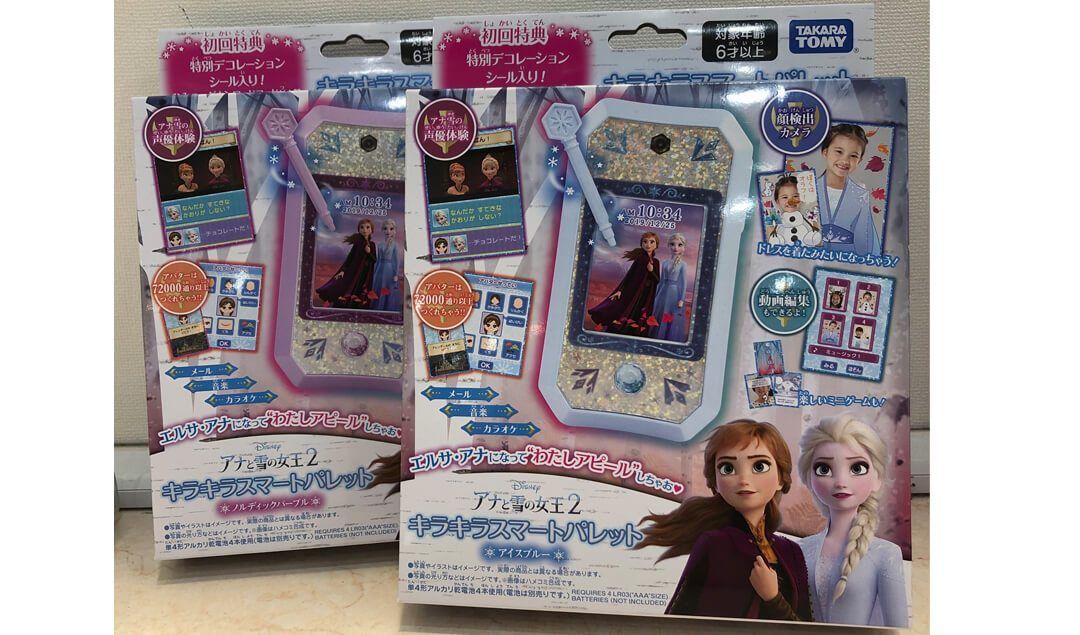
On the other hand, the popularity of seiyuu’s popularity in these years has also become significantly more complicated.
Besides the characters, because they have an affinity for the voice actors behind them, when this voice actress voices other characters, fans will also love the house and the new characters. These consumers see roles as idols, and those who simply like a roleThere are some differences.
The purpose of purchasing goods is also changing. Women’s products to characters have always been functional and can be put in bags. But now, instead of buying for “use”, consumer groups who are only satisfied with the “purchase” behavior are becoming more prominent. As a result, there are many non-common but strange products on the market.
Responding to this, peripheral stores, which have always been dominated by classic character goods, have had to take countermeasures, including popular characters on social media and nostalgic characters in the 1990s, to meet the changing tastes of consumers. The increase in the “shallow and widespread” role consumer groups shows that the role of “short-lived” characters has further deepened.
 p>
p>
Animated “star” endorsements
When roles are used in advertising and promotion, the target group’s awareness and favorability of the goods / services are important indicators for role selection.
The following figure shows the top 20 characters in the recognition and favorability of men and women aged 3-65 in Japan in 2018. The top 20 characters have basically reached a recognition rate of over 90%, which is almost the image of the Japanese people.
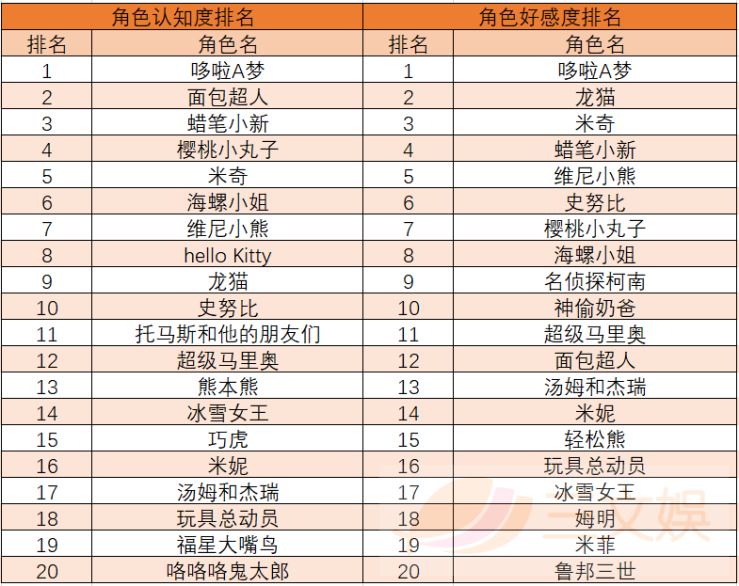 The top of the table is the 40th anniversary of the animation this year, “哆 “La Amen”, we can see that the longest-lasting animations. The degree of favorability and the degree of cognition are highly consistent, and the image with high cognition is also popular with the public. The commercial potential of these popular characters has directly attracted the popularity of entertainers and well-known athletes, and has gained widespread popularity, and has been adopted by various companies, goods and services for advertising and promotion.
The top of the table is the 40th anniversary of the animation this year, “哆 “La Amen”, we can see that the longest-lasting animations. The degree of favorability and the degree of cognition are highly consistent, and the image with high cognition is also popular with the public. The commercial potential of these popular characters has directly attracted the popularity of entertainers and well-known athletes, and has gained widespread popularity, and has been adopted by various companies, goods and services for advertising and promotion.
Advertising with animated characters or settings is nothing new. However, in recent years, major Japanese companies have come up with many tricks in this matter, and Japanese companies using animation characters are also involved in a wide range of industries, including catering, real estate, rail transit, media, banking, daily necessities, and so on. The following summarizes the main types of advertising and promotion using animation and their new development.
1. Use a character image as a packaging or promotional gift
The role of product packaging puts consumers in a stop when they pass by; and




 The reason for the shrinking market in 2018 is the lack of new popular characters At the same time, sales of previous classic characters have decreased. But the more important reason behind it is that the awareness of domestic consumers in Japan has changed in recent years.
The reason for the shrinking market in 2018 is the lack of new popular characters At the same time, sales of previous classic characters have decreased. But the more important reason behind it is that the awareness of domestic consumers in Japan has changed in recent years. 
When roles are used in advertising and promotion, the target group’s awareness and favorability of the goods / services are important indicators for role selection.
The following figure shows the top 20 characters in the recognition and favorability of men and women aged 3-65 in Japan in 2018. The top 20 characters have basically reached a recognition rate of over 90%, which is almost the image of the Japanese people.

Advertising with animated characters or settings is nothing new. However, in recent years, major Japanese companies have come up with many tricks in this matter, and Japanese companies using animation characters are also involved in a wide range of industries, including catering, real estate, rail transit, media, banking, daily necessities, and so on. The following summarizes the main types of advertising and promotion using animation and their new development.
1. Use a character image as a packaging or promotional gift
The role of product packaging puts consumers in a stop when they pass by; and